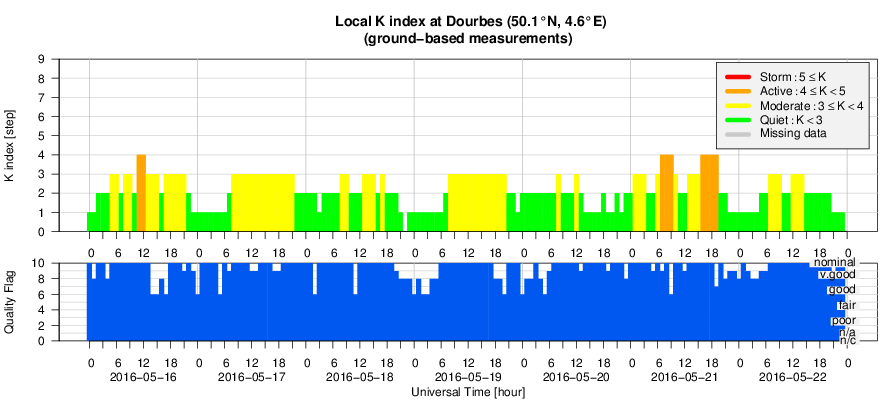- Table of Content
- 1.ESWW13 - We ha...
- 2.Roof tops on t...
- 3.Cosmic Rays Wo...
- 4.PROBA2 Observa...
- 5.Review of sola...
- 6.The Internatio...
- 7.Review of geom...
- 8.Geomagnetic Ob...
- 9.Review of iono...
- 10.Future Events
- 11.New documents ...
2. Roof tops on the plateau, Cosmic Rays and Wuthering Heights - STCE annual meeting
3. Cosmic Rays Workshop
4. PROBA2 Observations (16 May 2016 - 22 May 2016)
5. Review of solar activity
6. The International Sunspot Number
7. Review of geomagnetic activity
8. Geomagnetic Observations at Dourbes (16 May 2016 - 22 May 2016)
9. Review of ionospheric activity (16 May 2016 - 22 May 2016)
10. Future Events
11. New documents in the European Space Weather Portal Repository
ESWW13 - We have a date!
We are happy to announce that ESWW13 will take place from November 14 to 18, 2016 in Oostende, Belgium.
The deadline for submissions of contributions to sessions is delayed with one week: June 13 included.
http://www.stce.be/esww13/
Happy submission!
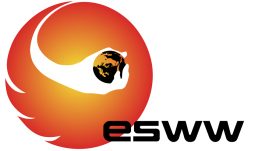
Roof tops on the plateau, Cosmic Rays and Wuthering Heights - STCE annual meeting
The 2016 edition of the STCE annual meeting takes place on Thursday June 9 and will lead you literally along Roof Top Science on the plateau. Places where you never have been before. Other highlights are the Cosmic Rays workshop, 10 years STCE and a Launch to Wuthering Heights.
Check it on https://events.oma.be/indico/event/9/
A preview
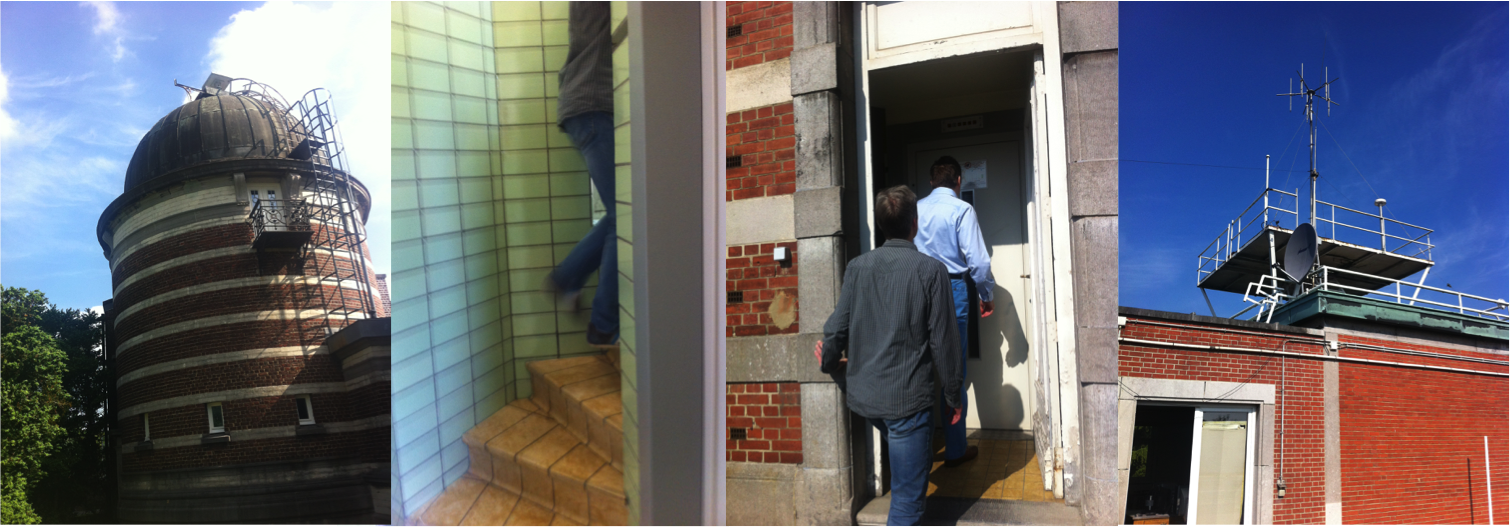
Cosmic Rays Workshop
Dourbes was the scenery for the workshop Cosmic Rays and Space Weather on May 17, 2016.
The participants were served a review of the history of cosmic ray monitoring given by a first hand source. The workshop continued with a discussion on neutron monitors and cosmic rays data. Cosmic rays that are able to reach the ground level are being captured by an array of tubes like on the picture.
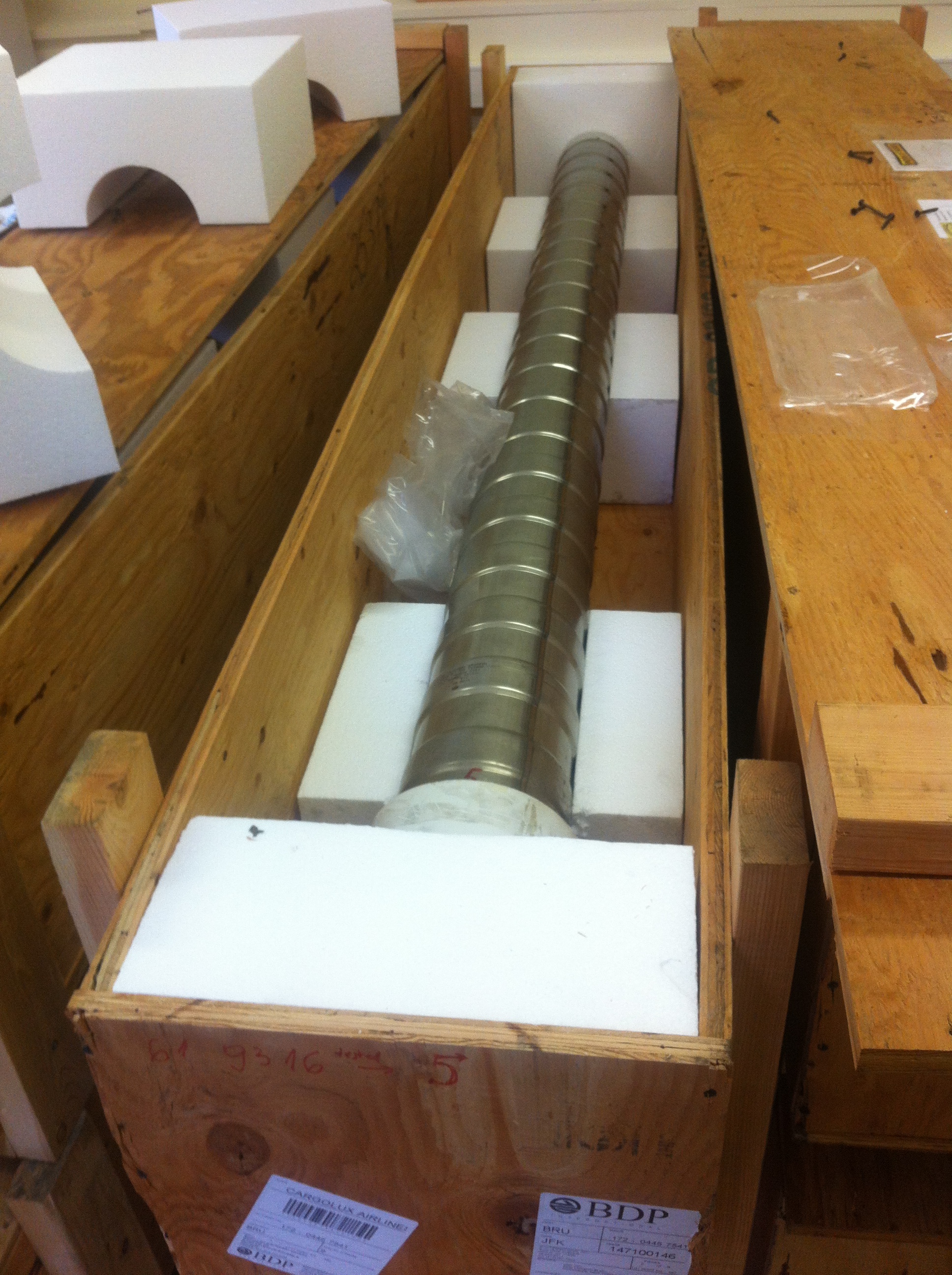
This tube makes part of the neutron monitor that will be installed in Dourbes.
The cosmic rays community is doing efforts to validate a worldwide neutron monitor netwerk and to design a common and modern registration system. Scientists and users need easy access to the data. It would also be a step forward if the data is provided in a standard format, in high resolution and in real-time.
Besides this, aviation is for sure impacted by cosmic rays. Pioneering monitoring work has been done already in this field, but this could be extended much more. Space Weather forecast centers could set up or upgrade the already existing Cosmic Rays warning and forecast services. This would also make sense for manned space missions.
As one can see, a wide range of research opportunities are waiting to be explored.
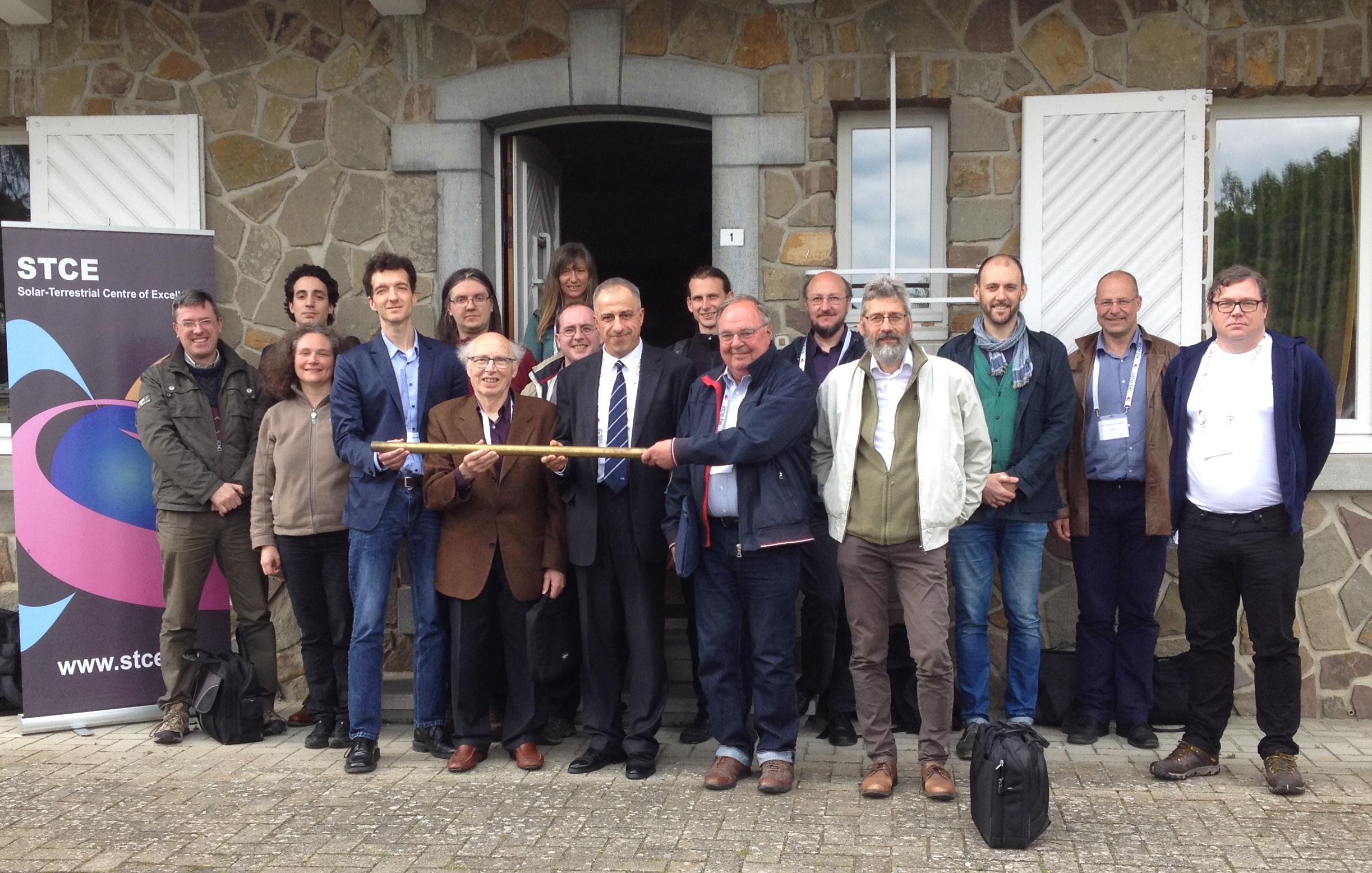
The participants of the May 17 Cosmic Rays workshop.
PROBA2 Observations (16 May 2016 - 22 May 2016)
Solar Activity
Solar flare activity fluctuated between very low and low during the week.
In order to view the activity of this week in more detail, we suggest to go to the following website from which all the daily (normal and difference) movies can be accessed:
http://proba2.oma.be/ssa
This page also lists the recorded flaring events.
A weekly overview movie can be found here (SWAP week 321).
http://proba2.oma.be/swap/data/mpg/movies/weekly_movies/weekly_movie_2016_05_16.mp4
Details about some of this week's events, can be found further below.
Monday May 16
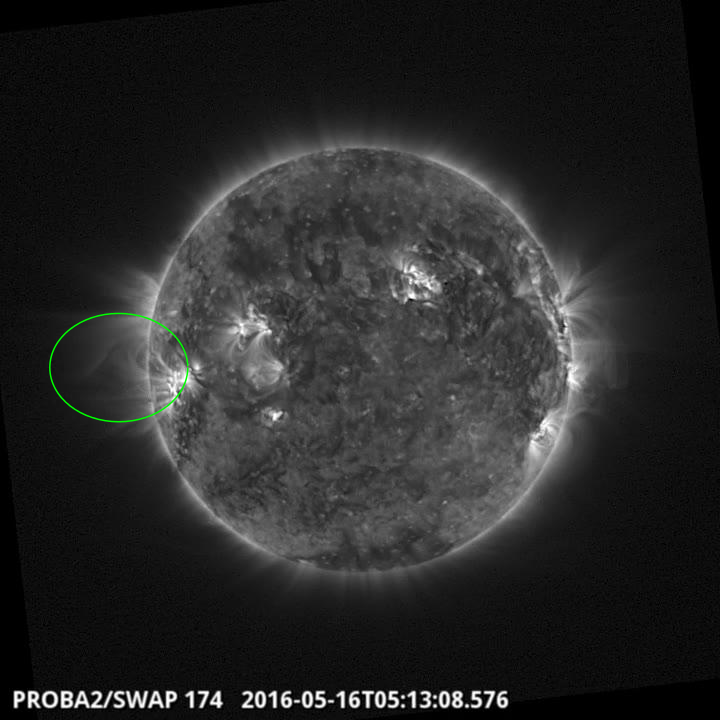
An eruption was observed by SWAP on the East limb of the Sun on 2016May16 at 05:13 UT
Find a movie of the events here (SWAP movie)
http://proba2.oma.be/swap/data/mpg/movies/20160516_swap_movie.mp4
Sunday May 22
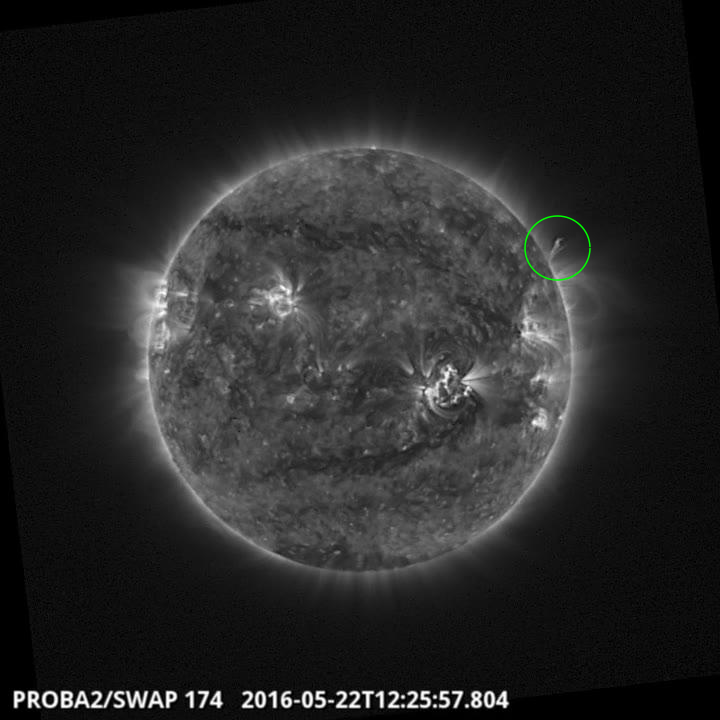
An eruption was observed by SWAP on the north west limb of the Sun at on 2016May22 at
12:25 UT
Find a movie of the events here (SWAP movie)
http://proba2.oma.be/swap/data/mpg/movies/20160522_swap_movie.mp4
Review of solar activity
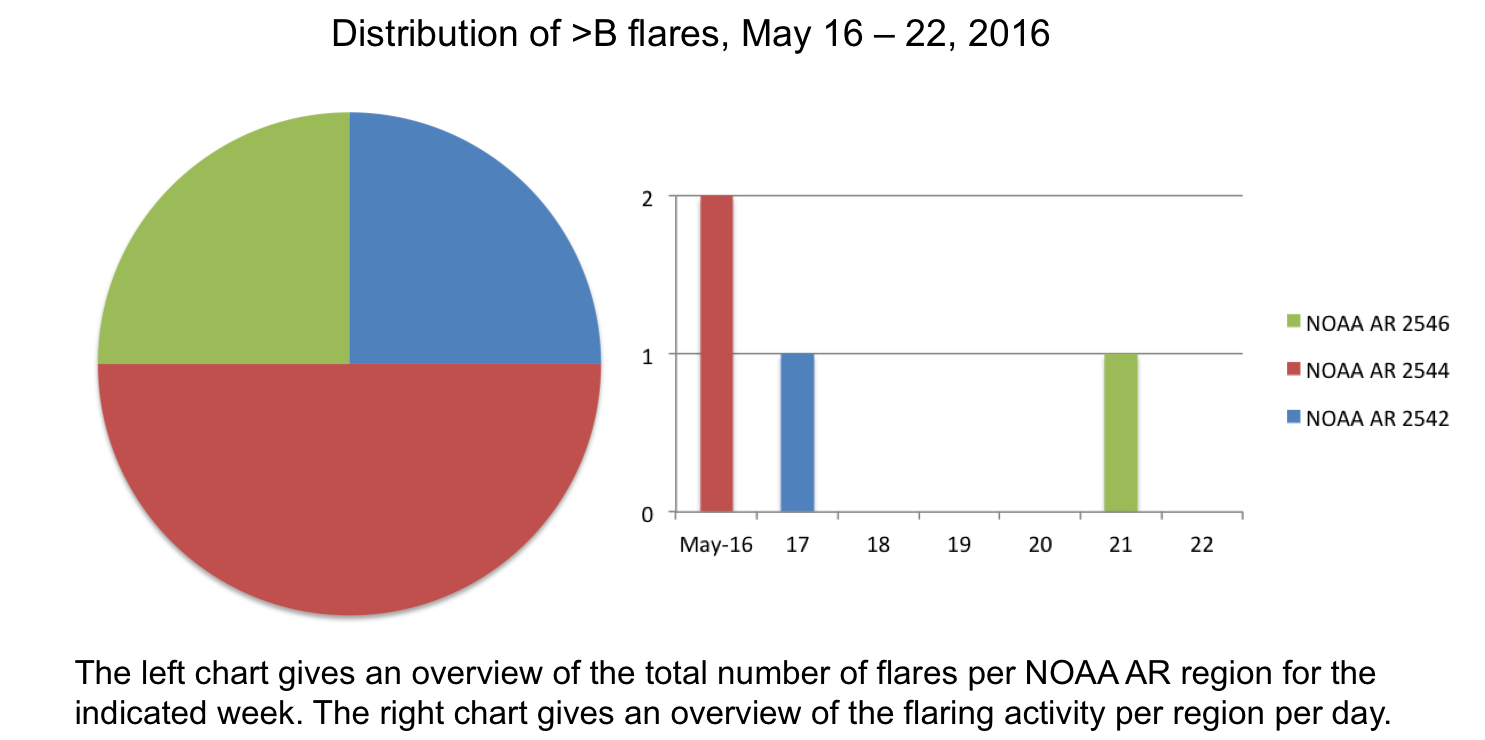
Solar activity was low. Active Region (AR) 2542 (Macintosh class:Cai; Mag. type:Beta) produced the largest flare, a C3.2 class flare, peaking at 16:03 UT on 15-May-2016. There were only two significant ARs on the solar disk last week; AR 2544 and AR 2546. AR 2542 rotated over the West limb on May 17. Both AR 2544 and AR 2546 showed low levels of activity, producing B and 3 C-class flares.
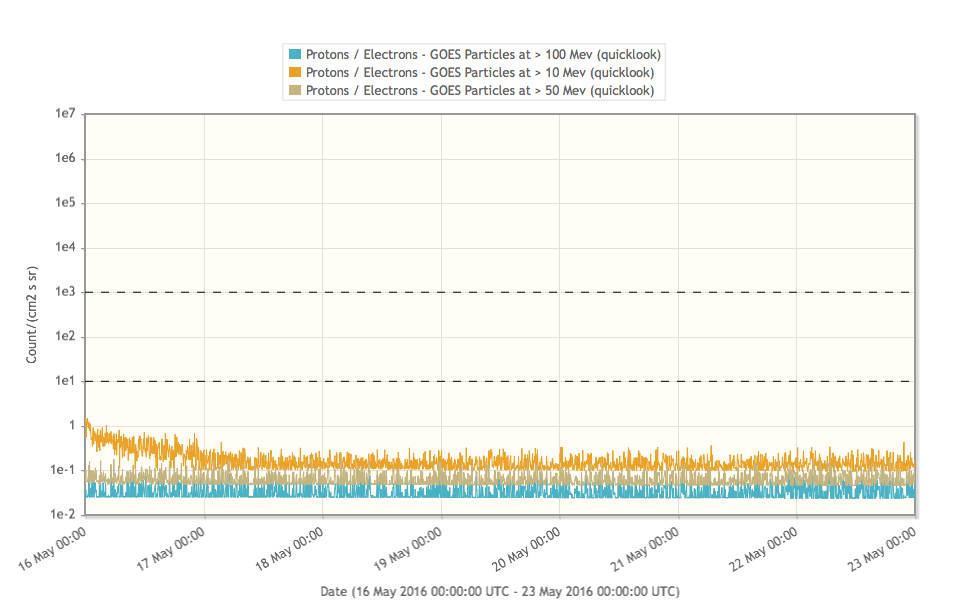
Solar protons have remained at background levels. The slightly elevated level on 16-May-2016 originates from a Westward directed CME (first seen in the SOHO/LASCO C2 field of view at 16:00 UT on 15-May-2016), which did not interact with the Earth system.
No Earth directed, or significant Coronal Mass Ejections (CMEs) were detected last week.
The International Sunspot Number
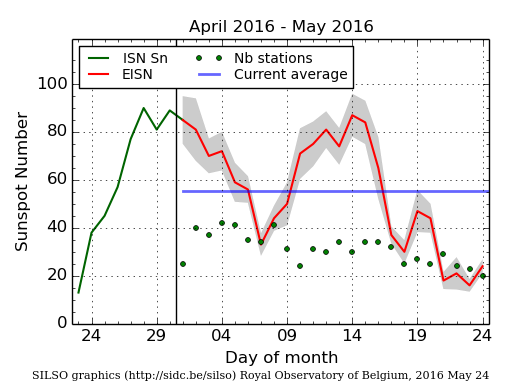
The daily Estimated International Sunspot Number (EISN, red curve with shaded error) derived by a simplified method from real-time data from the worldwide SILSO network. It extends the official Sunspot Number from the full processing of the preceding month (green line). The plot shows the last 30 days (about one solar rotation). The horizontal blue line shows the current monthly average, while the green dots give the number of stations included in the calculation of the EISN for each day.
Review of geomagnetic activity
The solar wind speed has fluctuated between 400 and 700 km/s over the past week. The total magnetic field strength has fluctuated between 5 and 10 nT peaking on 21-May-2016. The Bz component has fluctuated between -10 and +10 nT throughout the week.
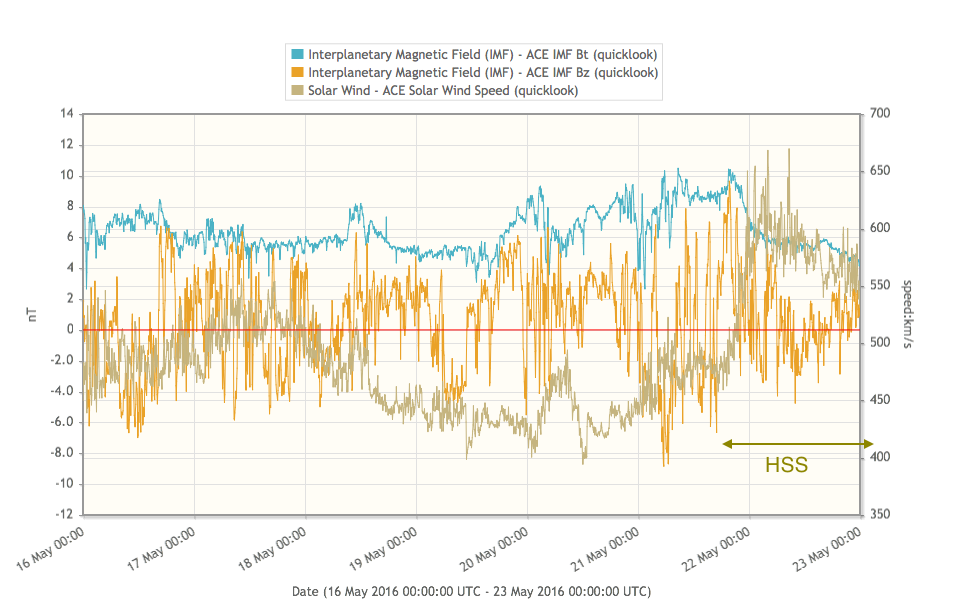
Geomagnetic conditions ranged between Kp index 0-5 (NOAA) and local K index 1-4 (Dourbes), but largely remained around the 2 and 3 levels. A large Northern polar coronal hole began the week in the central region, which slowly rotated across disk center and into the Western hemisphere throughout the week. The associated high-speed stream (HSS) increased solar wind speed speeds towards the end of the week. However, the solar wind speed only showed a small increase, causing the peak of 5 Kp on 21-May-2016.
Review of ionospheric activity (16 May 2016 - 22 May 2016)
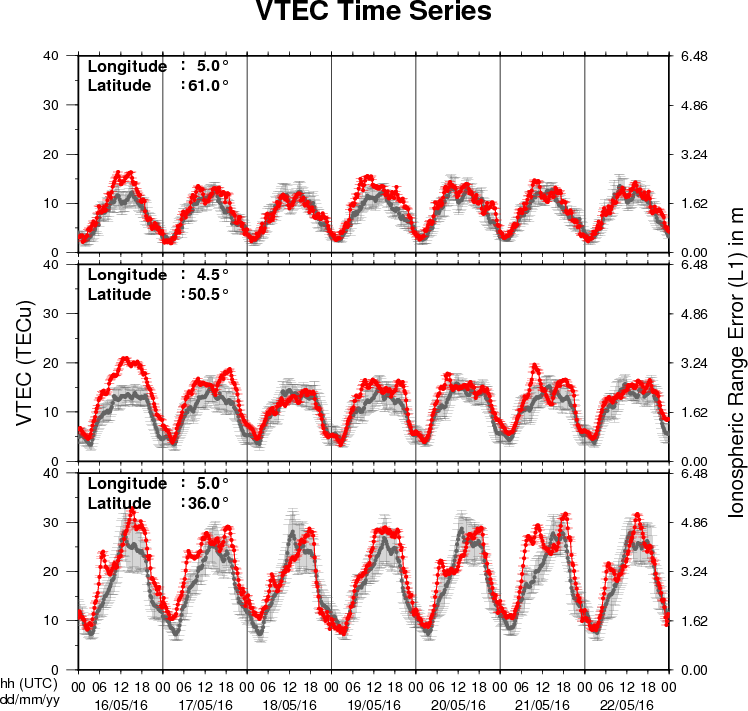
The figure shows the time evolution of the Vertical Total Electron Content (VTEC) (in red) during the last week at three locations:
a) in the northern part of Europe(N61°, 5°E)
b) above Brussels(N50.5°, 4.5°E)
c) in the southern part of Europe(N36°, 5°E)
This figure also shows (in grey) the normal ionospheric behaviour expected based on the median VTEC from the 15 previous days.
The VTEC is expressed in TECu (with TECu=10^16 electrons per square meter) and is directly related to the signal propagation delay due to the ionosphere (in figure: delay on GPS L1 frequency).
The Sun's radiation ionizes the Earth's upper atmosphere, the ionosphere, located from about 60km to 1000km above the Earth's surface.The ionization process in the ionosphere produces ions and free electrons. These electrons perturb the propagation of the GNSS (Global Navigation Satellite System) signals by inducing a so-called ionospheric delay.
See http://stce.be/newsletter/GNSS_final.pdf for some more explanations ; for detailed information, see http://gnss.be/ionosphere_tutorial.php
Future Events
For more details, see http://www.spaceweather.eu/en/event/future
Space Weather REDI Bootcamp
Start : 2016-06-07 - End : 2016-06-17
SW REDI summer Bootcamp is a two-week free training in space
weather, with the first week focusing on the fundamentals of space
weather and the second week on intensive forecaster training, with
alternative opportunities to discuss research topics with the CCMC
and NASA GSFC scientists.
The program is ideal for undergraduate and graduate students
interested in space weather forecasting or in space weather related
research but is also beneficial for scientists, engineers,
educators, mission operators, competitive high school students and
all others seeking to gain some basic knowledge regarding space
weather.
Website:
http://ccmc.gsfc.nasa.gov/support/SWREDI/bootcamp/
The Scientific Foundation of Space Weather
Start : 2016-06-27 - End : 2016-07-01
Website:
http://www.issibern.ch/program/workshops.html
Global Modelling of the Space Weather Chain in Helsinki, Finland
Start : 2016-10-24 - End : 2016-10-28
This event brings together solar, heliospheric, magnetospheric,
and ionospheric communities to discuss the current state and future
challenges in global modelling of the entire space weather chain.
Major developments in forecasting space weather, and understanding
the effects of solar eruptions requires increased communication and
collaboration of these often rather distinct communities. We
welcome submissions from these modelling communities and also
synergetic studies utilising both observations and numerical
models.
Website:
https://pnst.ias.u-psud.fr/sites/pnst/files/global_modelling_space_weather_oct2016.pdf
Solar Orbiter Workshop 7: Exploring the solar environs in Granada, Spain
Start : 2017-04-03 - End : 2017-04-06
This event will be hosted by the Instituto de Astrofisica de
Andalucia - CSIC. Please mind that on April 7th the 20th SWT
meeting will take place at the same venue.
Website: Unkown
New documents in the European Space Weather Portal Repository
See http://www.spaceweather.eu/en/repository
STCE - Cosmic Rays workshop: A brief history of the cosmic ray monitoring at RMI
Presentation given at the Cosmic Rays workshop
Check https://events.oma.be/indico/event/10/
http://www.spaceweather.eu/en/repository/show?id=602
STCE - Cosmic Rays workshop: Introduction and Research topics
Presentation given at the Cosmic Rays workshop
check https://events.oma.be/indico/event/10/
http://www.spaceweather.eu/en/repository/show?id=603
STCE - Cosmic Rays workshop: The Neutronminitor database (NMDB) and its applications to space weather
Presentation given at the Cosmic Rays workshop
check https://events.oma.be/indico/event/10/
http://www.spaceweather.eu/en/repository/show?id=604
STCE - Cosmic Rays workshop: GLE alerts as input for SEP forecasts
Presentation given at the Cosmic Rays workshop
check https://events.oma.be/indico/event/10/
http://www.spaceweather.eu/en/repository/show?id=605
STCE - Cosmic Rays workshop: Cosmic rays and dosimetry at aviation altitudes
Presentation given at the Cosmic Rays workshop
check https://events.oma.be/indico/event/10/
http://www.spaceweather.eu/en/repository/show?id=606
STCE - Cosmic Rays workshop: Radiation hazards for astronauts
Presentation given at the Cosmic Rays workshop
check https://events.oma.be/indico/event/10/
http://www.spaceweather.eu/en/repository/show?id=607
